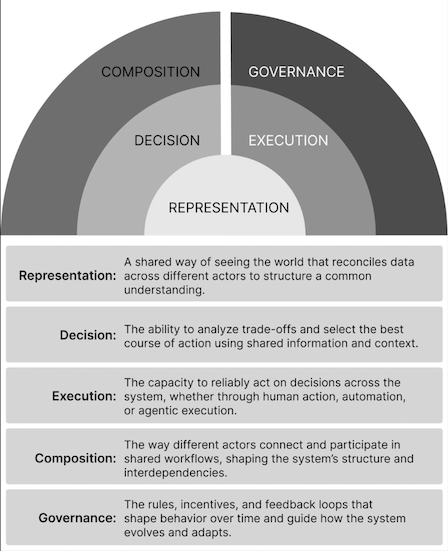I have just ended reading a great book title “Reshuffle”, you can have a summary from the author’s substack blog. This reading book completely reshaped my understanding of AI’s economic impact—I now see it not as a mere substitution of human labor with automation, but as a systemic shift in how coordination and value creation occur.
 Source: Sangeet Paul Choudary
Source: Sangeet Paul Choudary
However, we cannot foresee the ultimate consequences of the technology adoption, but for sure human will become redundant in some tasks and more relevant in other, especially those that requiere judgement of risk assumptions. The main mistake, in my view, is that we tend to see labor as tasks instead a means to serve a need.
We tend to treat economic growth and inequality as separate issues, as if one belongs to macroeconomics and the other to ethics. But they’re deeply intertwined. A growing system does not mean shared prosperity. In fact, growth and inequality often rise together, because the very mechanisms that expand the pie also determine how it’s divided.
The first part of the book shows AI not as a tool of automation or a means for substituting labor, instead a force that changes the system that solves a problem or server a purpose. This modification brings about a rebalance of how value is created and distributed, therefore redefining the power of economic agents. Thus, the impact of AI comes not from how it performs a task, but from how it restructures the entire system around that task. The author regards it as “unintelligent AI”, that its the advancements due to not “intellectual capabilities” but coordination or redesign of current processes.
AI doesn’t merely offer a better way to play the same old game. It offers an opportunity to reimagine the playing field in your favor.
The bottom line is that, success cases as Tiktok, Airbnb, Shein or Stripe, weren’t software eating the world but, it was coordination eating complexity. This algorithmic coordination underpins on (1) data collection and use, (2) growing communication capabilities, like mobile apps, that eliminated traditional constraints of trade, and (3) cloud services gave any player the computation capabilities without huge capital expenses. As new and more and more services are becoming available, so are “coordination gap” enlarging.
Two factors contribute to how AI enhances both the capacity and coordination required for knowledge work. First, AI reduces the cost of task execution. Tasks that once required expensive experts can now be performed more efficiently, at a lower price, and at scale.
Effective coordination in complex systems—such as travel planning—hinges on five key factors that make up a kind-of “operating system”, with the first three being unified representation, improved decision-making, and reliable execution. These elements address core fragmentation issues: miscommunication between players, decision ambiguity, and inconsistent execution. AI helps overcome these challenges by creating a shared representation of the environment across disparate stakeholders, like airlines, hotels, and local services. Unlike traditional systems that rely on upfront consensus (e.g., standard containers in shipping), AI enables coordination to emerge organically by translating and aligning diverse data formats. This shared structure provides a common foundation for participants to work together, even when they initially operate under different standards.
 The Architecture of Coordination. Source: Reshuffle
The Architecture of Coordination. Source: Reshuffle
Once a unified representation is in place, stakeholders can make better, more aligned decisions. However, information alone doesn’t guarantee effective coordination—what’s needed is the ability to interpret trade-offs and act accordingly. AI excels at this, processing vast and varied data, identifying relevant patterns, and delivering personalized recommendations. This not only reduces ambiguity but also aligns execution across the system. AI supports execution in two key ways: assistively, by enhancing human decision-making with relevant data and suggestions, and agentically, by taking autonomous action when needed—like rebooking disrupted travel plans. Together, these capabilities enable AI to align system actors around shared goals, driving more reliable, scalable coordination.
What makes AI-powered coordination different is that it doesn’t need consensus to begin. By recognizing patterns in unstructured data, AI bridges gaps between systems that were never built to connect.
The final two elements of effective coordination are composition and governance. Composition defines how different actors connect and collaborate within shared workflows, shaping the overall structure of the system. In environments built on consensus—like container shipping or API-based software—composition is straightforward, with clear standards and interfaces. However, in systems lacking such consensus, aligning diverse participants becomes far more complex and potentially chaotic.
 The flywheel of economic growth. Source: Reshuffle
The flywheel of economic growth. Source: Reshuffle
In economic systems, the most relevant breakthroughs don’t come from making individual parts faster or less expensive, but making the system work better. Take the use of standard containers in trade shipments, it gave rise a dramatic reduction in delivery time and costs. Before containerization, companies stayed vertically integrated because coordinating with external suppliers was difficult and expensive. Containerization changed that by dramatically lowering coordination costs, enabling firms to source globally, switch suppliers easily, and focus on cost and quality. This led to greater specialization among suppliers, which improved both components and final products. As firms specialized further, they needed even tighter coordination to manage fragmented supply chains. This created a self-reinforcing flywheel: better coordination enables deeper specialization, which increases fragmentation, which in turn requires even more advanced coordination—ultimately driving economic growth.